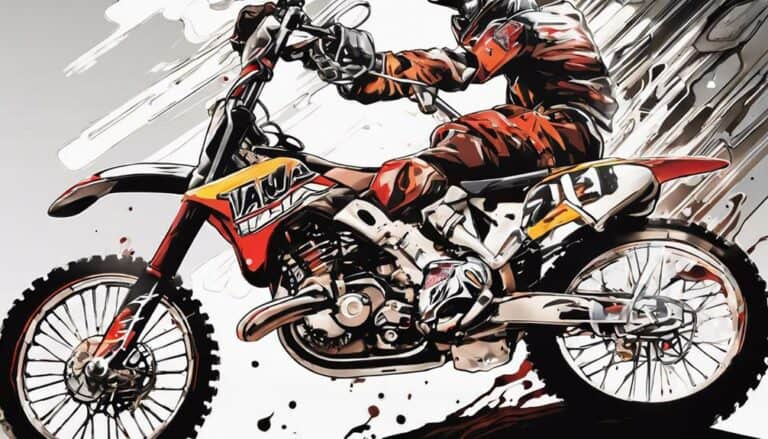When it comes to bleeding a dirt bike clutch using Vacula, think of it as giving your bike a well-deserved rejuvenation.
The precision and efficiency of this method can greatly enhance your riding experience.
So, imagine the satisfaction of smoothly shifting gears and effortlessly traveling through challenging terrains after mastering this important maintenance task.
Ready to elevate your clutch performance? Let's get started on this essential procedure that can make a world of difference in your dirt bike adventures.
Key Takeaways
- Efficiently set up Vacula equipment for quick and thorough air removal during clutch bleeding.
- Ensure proper dirt bike preparation for effective bleeding and prevent contamination.
- Use Vacula pump to remove old fluid and air, monitoring fluid levels for a smooth clutch operation.
- Test clutch functionality post-bleeding through gear shifting and responsiveness checks.
Setting up the Vacula Equipment
To set up the Vacula equipment for bleeding a dirt bike clutch, begin by ensuring you have all the necessary components, including the hand pump, reservoir, gauge, and appropriate adapters. The hand pump plays an important role in creating the vacuum pressure needed to efficiently remove air and old fluid from the clutch system.
Make sure to attach the suitable adapter to the clutch bleeder screw securely, as this connection is essential for the vacuum process to work effectively. The gauge on the Vacula equipment is your tool for monitoring the vacuum pressure, ensuring that the clutch system is bled correctly.
Troubleshooting common issues such as leaks or improper connections is key to a successful bleed. Understanding the vacuum bleeding benefits, like faster and more thorough air removal compared to traditional methods, highlights the efficiency and effectiveness of using the Vacula equipment.
Preparing the Dirt Bike for Bleeding
If you have completed setting up the Vacula equipment, the next step in bleeding your dirt bike clutch involves preparing the bike for the process. Start by making sure the dirt bike is on a stable surface with the handlebars straight. This setup prevents fluid loss during the bleeding process. Additionally, clean the clutch reservoir and cap to prevent any contaminants from entering the system during bleeding.
Before beginning the bleeding process, it's important to check the fluid levels in the reservoir. Keeping an eye on the fluid level helps prevent air from entering the system while using the vacula for bleeding. This step ensures a smooth and effective bleeding process.
Another essential aspect of preparing the dirt bike is to securely attach the vacula hose to the bleeder screw. This attachment allows for the extraction of old fluid and air from the clutch system efficiently. By following these steps and precautions, you can effectively prepare your dirt bike for the bleeding process, ensuring excellent results and preventing contamination.
Bleeding the Clutch System
How can you effectively bleed the clutch system of your dirt bike using the Vacula vacuum pump?
To bleed the clutch system efficiently, connect the Vacula vacuum pump to the bleeder nipple on the clutch slave cylinder. Apply vacuum pressure to draw out old fluid and air from the system. It's important to monitor the fluid level in the reservoir constantly to prevent air from entering the system during the bleeding process. Keep the vacuum pump connected until clean fluid is observed coming out of the system. Once the bleeding is complete, tighten the bleeder nipple securely and test the clutch lever for proper pressure and smooth operation.
Common mistakes when bleeding a clutch system include not maintaining the vacuum pressure consistently, allowing air to re-enter the system, and not checking the fluid level frequently. Troubleshooting tips involve double-checking all connections, ensuring the vacuum pump is functioning correctly, and verifying that there are no leaks in the system.
Testing Clutch Functionality
Confirm the clutch lever exhibits a vital and consistent feel when squeezed to assess its functionality accurately. After verifying the lever's resistance, proceed to test the clutch engagement by smoothly shifting gears without experiencing any slippage. Guarantee there's no delay or drag when releasing the lever, as this could indicate issues within the clutch mechanism.
Keep an ear out for any unusual noises or vibrations during clutch operation, as these could be signs of underlying problems that require attention. To further evaluate the clutch's performance, conduct a series of start-stop tests to gauge responsiveness and grip. These steps are critical in determining the overall health of your clutch system and can help in identifying potential areas for clutch maintenance or troubleshooting tips.
Stay vigilant throughout the testing process to catch any irregularities early on.
Final Checks and Maintenance Tips
Inspect the bleeder screw and reservoir cap for any signs of leaks as part of your final checks and maintenance routine. Make sure that both components are tightly secured to prevent any fluid from escaping.
Check the clutch lever for a firm and consistent feel, confirming successful bleeding. Any abnormalities may indicate a need for further inspection.
It's important to maintain the proper fluid level in the reservoir to guarantee ideal clutch operation. Top up the fluid if necessary to prevent air from entering the system.
Test the clutch engagement and disengagement while stationary to verify smooth functionality. Keep a maintenance schedule to record when the clutch was last bled, ensuring timely upkeep for peak performance.
Conclusion
Now that you have successfully bled your dirt bike clutch using Vacula, validate all connections are secure and free of leaks.
Test the clutch lever for smooth operation and feel the difference in performance.
Remember to regularly check and maintain your clutch system to keep your dirt bike running smoothly.
Stay tuned for more maintenance tips and tricks to keep your bike in top condition.
Ride on!

